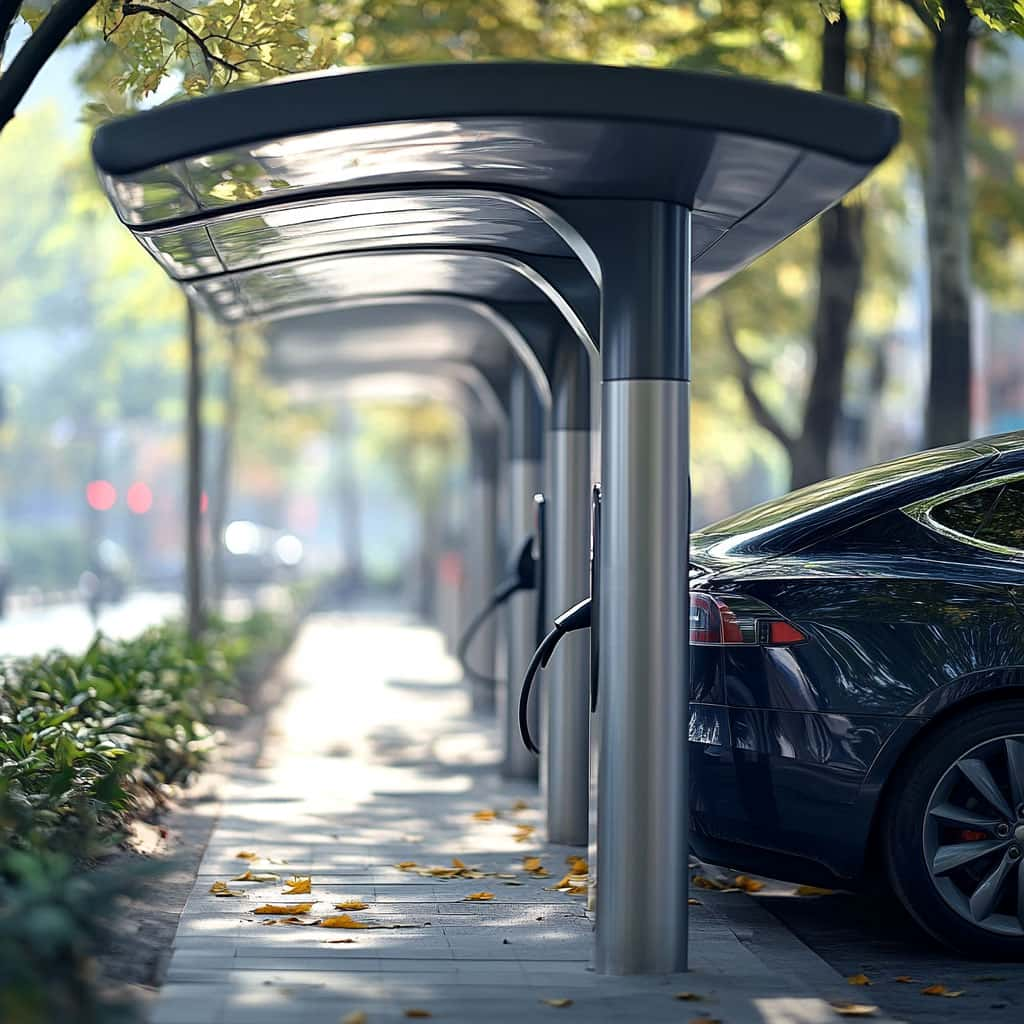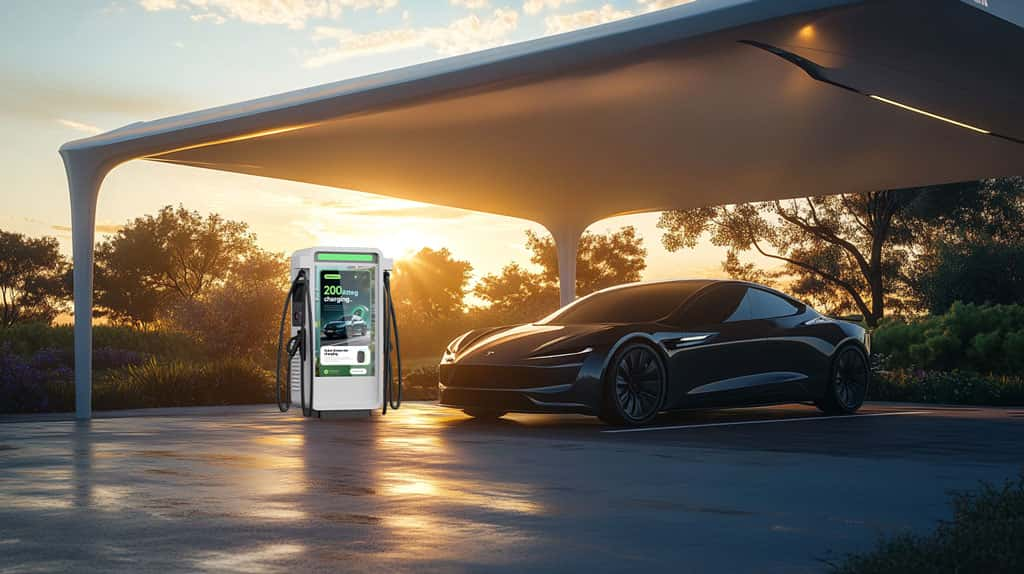As summer temperatures continue to rise, electric vehicle owners may start to focus on an important issue: EV charging precautions in hot weather. High temperatures not only affect our comfort but also pose challenges to EV battery performance and charging safety. Understanding how to properly charge your electric vehicle in hot weather is crucial for protecting your car's battery health, extending its lifespan, and ensuring charging efficiency. This article will delve into the impact of high temperatures on electric vehicles and provide you with a series of practical best practices and expert advice for summer charging, helping you navigate the hot summer with peace of mind.
How Do High Temperatures Affect EV Batteries and Charging Efficiency?
The core of an electric vehicle is its lithium-ion battery pack. These batteries perform best within a specific temperature range, typically between 20∘C and 25∘C. When the ambient temperature rises, especially above 35∘C, the electrochemical reactions inside the battery are significantly affected, which in turn impacts its performance, lifespan, and charging process.
Firstly, high temperatures accelerate the chemical degradation process within the battery. This can lead to a permanent reduction in battery capacity, commonly known as battery degradation. Prolonged exposure to high temperatures during charging can cause the electrolyte inside the battery to decompose, forming a passivation layer that hinders the flow of lithium ions, thereby reducing the battery's usable capacity and power output.
Secondly, high temperatures also increase the battery's internal resistance. An increase in internal resistance means that the battery generates more heat during charging or discharging. This creates a vicious cycle: high ambient temperature leads to increased battery temperature, which further increases internal resistance and heat generation, ultimately potentially triggering the Battery Management System (BMS) protection mechanism.
The BMS is the 'brain' of the EV battery, responsible for monitoring the battery's voltage, current, and temperature. When the BMS detects that the battery temperature is too high, to protect the battery from damage, it will actively reduce the charging power, leading to slower charging speeds. In extreme cases, the BMS may even pause charging until the battery temperature drops to a safe range. This means that in the hot summer, you might find that charging takes longer than usual, or the charging speed doesn't meet expectations.
The table below briefly compares battery performance at ideal temperatures and high temperatures:
| Feature | Ideal Temperature (20∘C−25∘C) | High Temperature (>35∘C) |
| Battery Capacity | Stable, slow degradation | Accelerated degradation, capacity reduction |
| Internal Resistance | Lower | Increases, more heat generated |
| Charging Speed | Normal, efficient | BMS limits, charging slows or pauses |
| Battery Lifespan | Longer | Shortened |
| Energy Conversion Efficiency | High | Reduced due to heat loss" |
Best Practices for EV Charging in Summer
To ensure your electric vehicle charges safely and efficiently even in hot summer weather, it's crucial to follow these best practices.
Choosing the Right Charging Location and Time
The choice of charging environment directly impacts battery temperature.
•Prioritize charging in shaded areas: Whenever possible, charge your EV in a garage, underground parking lot, or under a canopy. Avoid prolonged exposure of your vehicle and charging station to direct sunlight. Direct sunlight can significantly raise the surface temperature of the battery and charging equipment, increasing the thermal load.
•Charge at night or in the early morning: Temperatures are highest during the day, especially in the afternoon. Opt to charge when temperatures are lower, such as at night or in the early morning. Many EVs support scheduled charging, allowing you to set the car to automatically start charging during cooler, off-peak electricity hours. This not only helps protect the battery but can also save you money on electricity bills.
•Protect your charging station: If you're using a home charging station, consider installing a sunshade or placing it in a shaded area. The charging station itself can also be affected by high temperatures, potentially impacting its performance or triggering overheating protection.
Optimizing Charging Habits for Battery Health
Correct charging habits are key to extending the lifespan of your EV battery.
•Maintain a 20%-80% charging range: Try to avoid fully charging (100%) or completely depleting (0%) your battery. Keeping the charge level between 20% and 80% helps reduce stress on the battery and slows down degradation, especially in hot environments.
•Avoid immediate charging when the battery is hot: If your EV has just been on a long drive or exposed to direct sunlight for an extended period, the battery temperature might be high. It's not advisable to immediately engage in high-power charging at this time. Let the vehicle rest for a while, allowing the battery temperature to naturally drop before charging.
•Consider using Slow Charging: Compared to DC fast charging, AC slow charging (Level 1 or Level 2) generates less heat. During hot summer periods, if time permits, prioritize Slow Charging. This allows the battery more time to dissipate heat, thereby reducing potential damage to the battery.
•Regularly check tire pressure: Underinflated tires increase friction with the road, leading to higher energy consumption, which indirectly increases the battery's load and heat generation. In summer, tire pressure can change due to rising temperatures, so regularly checking and maintaining correct tire pressure is very important.
Utilizing In-Car Smart Systems for Temperature Management
Modern electric vehicles are often equipped with advanced battery management and cabin preconditioning features. Leveraging these functions can effectively combat high temperatures.
•Preconditioning function: Many EVs support pre-activating the air conditioning during charging to cool the cabin and battery. 15-30 minutes before you plan to depart, activate preconditioning via your car's system or mobile app. This way, the AC power will come from the grid rather than the battery, allowing you to enter a cool cabin and ensuring the battery starts operating at its optimal temperature, thus saving battery energy during driving.
•Remote cooling control: Even when you're not in the car, you can remotely turn on the air conditioning via your mobile app to lower the interior temperature. This is especially useful for vehicles parked in direct sunlight for extended periods.
•Understanding BMS (Battery Management System): Your EV's built-in BMS is the guardian of battery safety. It continuously monitors the battery's health and temperature. When the battery temperature gets too high, the BMS will automatically take measures, such as limiting charging power or activating the cooling system. Understand how your vehicle's BMS works and pay attention to any warning messages from your vehicle.
•Enable Cabin Overheat Protection: Many EVs offer a "Cabin Overheat Protection" feature that automatically turns on the fan or AC to cool the cabin when the interior temperature exceeds a set value. This helps protect in-car electronics and the battery from heat damage.
High-Temperature Strategies for Different Charging Types
Different charging types behave differently in high temperatures, requiring varied strategies.
| Charging Type | Power Range | Characteristics in High Temperatures | Strategy |
| Level 1 (AC Slow Charging) | 1.4-2.4kW | Slowest charging speed, least heat generated, minimal impact on battery. | Best suited for daily summer charging, especially at night or when the vehicle is parked for extended periods. Virtually no additional concerns about battery overheating. |
| Level 2 (AC Slow Charging) | 3.3-19.2kW | Moderate charging speed, generates less heat than fast charging, typical for home charging stations. | Still the recommended daily charging method in summer. Charging in shaded areas or at night is more effective. If the vehicle has a preconditioning function, it can be activated during charging. |
| DC Fast Charging (DC Fast Charging) | 50kW-350kW+ | Fastest charging speed, most heat generated, BMS speed limitation is most common. | Try to avoid using during the hottest part of the day. If you must use it, choose charging stations with awnings or located indoors. Before starting fast charging, you can use the vehicle's navigation system to plan your route, giving the BMS time to precondition the battery temperature to its optimal state. Pay attention to changes in the vehicle's charging power; if you notice a significant drop in charging speed, it might be the BMS limiting the speed to protect the battery." |

Common Misconceptions and Expert Advice
When it comes to charging electric vehicles in summer, there are some common misconceptions. Understanding these and heeding expert advice is crucial.
Common Misconceptions
•Misconception 1: You can fast charge arbitrarily in high temperatures.
•Correction: High temperatures increase battery internal resistance and heat generation. Frequent or prolonged high-power fast charging in hot conditions can accelerate battery degradation and may even trigger overheating protection, leading to charging interruptions.
•Misconception 2: It's fine to charge immediately after the battery gets hot.
•Correction: After a vehicle has been exposed to high temperatures or driven intensely, the battery temperature can be very high. Charging immediately at this point puts additional stress on the battery. You should let the vehicle rest for a while, allowing the battery temperature to naturally drop before charging.
•Misconception 3: Frequently charging to 100% is better for the battery.
•Correction: Lithium-ion batteries experience higher internal pressure and activity when close to 100% full or 0% empty. Maintaining these extreme states for prolonged periods, especially in high temperatures, can accelerate battery capacity loss.
Expert Advice
•Follow Manufacturer Guidelines: The battery characteristics and BMS strategies of each electric vehicle may vary slightly. Always consult your vehicle's owner's manual for specific recommendations and limitations regarding high-temperature charging from the manufacturer.
•Pay Attention to Vehicle Warning Messages: Your EV's dashboard or central display may show warnings for high battery temperature or charging anomalies. If such alerts appear, you should immediately stop charging or driving and follow the vehicle's instructions.
•Regularly Check Coolant: Many EV battery packs are equipped with liquid cooling systems. Regularly checking the coolant level and quality ensures the cooling system can function effectively, which is crucial for battery thermal management.
•Use Data for Decision-Making: If your vehicle app or a third-party charging app provides battery temperature or charging power data, learn to interpret this information. When you notice consistently high battery temperatures or an abnormal drop in charging power, adjust your charging strategy accordingly.
EV Charging Station High-Temperature Protection and Maintenance Guide
Beyond focusing on the electric vehicle itself, the protection and maintenance of charging stations in high temperatures should not be overlooked.
•Protection for Home Charging Stations (EVSE):
•Shade: If your home charging station is installed outdoors, consider installing a simple sunshade or canopy to protect it from direct sunlight.
•Ventilation: Ensure good ventilation around the charging station to prevent heat accumulation.
•Regular Inspection: Periodically check the charging gun head and cable for signs of overheating, discoloration, or damage. Loose connections can also lead to increased resistance and heat generation.
•Considerations for Public Charging Stations:
•Many public charging stations, especially fast-charging stations, have built-in cooling systems to cope with high temperatures. However, users should still prioritize charging stations with overhead covers or those located in indoor parking lots.
•Some charging stations may actively reduce charging power during extreme hot weather. This is to protect the equipment and vehicle safety, so please understand and cooperate.
ummer's high temperatures do present challenges for electric vehicle batteries and the charging process. However, by taking the right EV charging precautions in hot weather, you can effectively protect your car, ensure its battery health, and maintain an efficient charging experience. Remember, choosing the appropriate charging time and location, optimizing your charging habits, and making good use of your vehicle's smart features are all key to ensuring your electric vehicle sails through the summer safely.
Post time: Jul-31-2025



